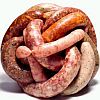The idiot's guide
63 posts
• Page 3 of 5 • 1, 2, 3, 4, 5
Yes should be no problem at all. Some folks like to have some saltpetre in there because it does add to the flavour, but I doubt you'll miss it if you've never used it before.
Dave
Dave
Curing is not an exact science... So it's not a sin to bin.
Great hams, from little acorns grow...
Great hams, from little acorns grow...
-

saucisson - Site Admin
- Posts: 6851
- Joined: Sat Mar 04, 2006 8:46 pm
- Location: Oxford UK
The curing salts will give the ham a nice colour I assume?
It always gives a great colour to the bacon I do.
I am not too worried about taste as the other herbs etc will do that.
It is the colour I am more intrerested in.
What do you think? It says on the paperwork it will colour all meats.
It always gives a great colour to the bacon I do.
I am not too worried about taste as the other herbs etc will do that.
It is the colour I am more intrerested in.
What do you think? It says on the paperwork it will colour all meats.
-

johnfb - Global Moderator
- Posts: 2427
- Joined: Mon Aug 13, 2007 10:03 am
- Location: Dublin, Ireland
Thanks Dave you're a wealth of knowledge. It's strange but I always feel better when you guys confrm my own thinking.
This really was the idiots guide afterall...but well worth it.
Thanks everyone, I think I have all I need now.
Yipeeeee!!!!!!!
-

johnfb - Global Moderator
- Posts: 2427
- Joined: Mon Aug 13, 2007 10:03 am
- Location: Dublin, Ireland
Gidday
As I am an old rough country boy who only has sheep and no pigs, can I treat me mutton the same way as pork. Like I mean the same percentages of bring to meat?
As I am an old rough country boy who only has sheep and no pigs, can I treat me mutton the same way as pork. Like I mean the same percentages of bring to meat?
Cheers
Jack
Just a rough Country Boy
Jack
Just a rough Country Boy
- Rough Country Boy
- Registered Member
- Posts: 25
- Joined: Tue Mar 07, 2006 11:14 am
- Location: Duntroon New Zealand
Welcome  I'm sure you can, I'm itching to try this...
I'm sure you can, I'm itching to try this...
James�s McGeough�s (of Oughterard, Galway) famous Connemara Smoked Lamb (only produced in 4 other countries in the world). All his meats and suppliers are Irish. Connemara Lamb is cured for two weeks; he sweats them in a mixture of rosemary, mint, garlic and salt. Then the lamb is cold smoked over beach/hickory or oak. Next they are rinsed compressed in to rough cubes in a press and hung for three months.
Dave
James�s McGeough�s (of Oughterard, Galway) famous Connemara Smoked Lamb (only produced in 4 other countries in the world). All his meats and suppliers are Irish. Connemara Lamb is cured for two weeks; he sweats them in a mixture of rosemary, mint, garlic and salt. Then the lamb is cold smoked over beach/hickory or oak. Next they are rinsed compressed in to rough cubes in a press and hung for three months.
Dave
Curing is not an exact science... So it's not a sin to bin.
Great hams, from little acorns grow...
Great hams, from little acorns grow...
-

saucisson - Site Admin
- Posts: 6851
- Joined: Sat Mar 04, 2006 8:46 pm
- Location: Oxford UK
There is also a traditon for curing sheep in the Shetland Islands...
http://www.tasteshetland.com/history.php[/quote]
Phil
Reestit Mutton
The meat would be salted in brine and then would be hung in the rafters of the house usually above the peat fire. The smoke would season the meat. Reestit Mutton is still popular today and can be seen still hanging in many houses, especially in the rural communities. It is also sold in some shops although, increasingly and contrary to tradition, lamb is used rather than mutton. Reestit Mutton is probably as close to being Shetland's national dish as is possible.
Vivda
The term 'Vivda' is said to be old Norse for 'leg meat'. It is probable that Vivda was more traditional in Shetland that Reestit Mutton, certainly until salt became more widespread as a preservative.
The meat would be dried in special ventilated stone houses called 'Skeos' and would be sited nearby the seashore in order to harness the salty air. Some meat was actually dried in caves. Many of these Skeos can still be seen today. Vivda would be dried without any salt being applied and would hang for around 4-5 months before being consumed.
Unfortunately, consumption of Vivda began to die out in the late 18th century and by the mid 19th, had disappeared almost all together. Vivda remains a steadfast delicacy in the Faroe Islands and variations on a theme are widespread in the other Scandinavian territories. At present Taste Shetland are engaged in reviving this product.
http://www.tasteshetland.com/history.php[/quote]
Phil
Last edited by wheels on Mon Aug 17, 2009 11:57 am, edited 1 time in total.
-

wheels - Global Moderator
- Posts: 12894
- Joined: Sat Sep 02, 2006 4:29 pm
- Location: Leicestershire, UK
Gidday
Hey thanks ewe jokers. You really are a bunch of bloody champians.
When I was a boy we lived on a very poor bank country farm and is we didn't grow it we just didn't eat it. We had no electricity so therefore no refridgeration so our meat would never last for more than a week unless it was cured in some way. There was a shed, about 12 by 15 feet, weatherboard but no lining, It had a bug barrel for bring curing and an old bath tub where things were dry cured and in a corner was a fireplace but there was no chimney so all the curing and smoking was done in the one place. But my Grand parents place had a very large open fire with a corrigated iron chimney where all their cooking was done and they smoked their meat simply by hanging it up inside the chimney.
My biggest trouble is I was too younge to remember any other details and now I am bloody nearly too old to do anything about it so I have to pull finger and recreate it so that I can hand it on to my decendants.
Cheers
Jack
Hey thanks ewe jokers. You really are a bunch of bloody champians.
When I was a boy we lived on a very poor bank country farm and is we didn't grow it we just didn't eat it. We had no electricity so therefore no refridgeration so our meat would never last for more than a week unless it was cured in some way. There was a shed, about 12 by 15 feet, weatherboard but no lining, It had a bug barrel for bring curing and an old bath tub where things were dry cured and in a corner was a fireplace but there was no chimney so all the curing and smoking was done in the one place. But my Grand parents place had a very large open fire with a corrigated iron chimney where all their cooking was done and they smoked their meat simply by hanging it up inside the chimney.
My biggest trouble is I was too younge to remember any other details and now I am bloody nearly too old to do anything about it so I have to pull finger and recreate it so that I can hand it on to my decendants.
Cheers
Jack
Cheers
Jack
Just a rough Country Boy
Jack
Just a rough Country Boy
- Rough Country Boy
- Registered Member
- Posts: 25
- Joined: Tue Mar 07, 2006 11:14 am
- Location: Duntroon New Zealand
Let us know how it goes, Dave, as I will be interested in trying that. Central Texas is sheep and goat country.
And belated happy birthday!
And belated happy birthday!
" To be the stewards of what we have been given, to reap what we sow, to enjoy the harmony of it all.
me
me
- vinner
- Registered Member
- Posts: 554
- Joined: Fri Mar 31, 2006 12:22 am
- Location: Texas
Birthday isn't until the 17th, but thanks 
I will be one year short of my half century or to put it another way my brother and I will be 98 between us
or to put it another way my brother and I will be 98 between us 
I have an inkling of what my pressies will be and they may be of interest to the forum, if they are expect pictures
Dave
I will be one year short of my half century
I have an inkling of what my pressies will be and they may be of interest to the forum, if they are expect pictures
Dave
Curing is not an exact science... So it's not a sin to bin.
Great hams, from little acorns grow...
Great hams, from little acorns grow...
-

saucisson - Site Admin
- Posts: 6851
- Joined: Sat Mar 04, 2006 8:46 pm
- Location: Oxford UK
63 posts
• Page 3 of 5 • 1, 2, 3, 4, 5
Return to Recipes for cured meats
Who is online
Users browsing this forum: No registered users and 3 guests


